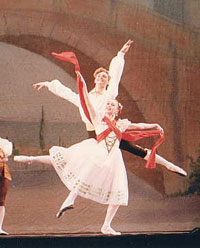
Choreography: August Bournonville
Music: Helsted/Paulli
August Bournonville was born and raised in Copenhagen, Denmark, where his French father was Ballet Master at the Royal Theater. Bournonville trained as a dancer and made two extended visits to Paris to train with the famous performer and teacher Vestris. On return from his second trip to Paris he started to choreograph and staged several ballets which he had seen abroad. Today, Bournonville’s ballets remain the only extant examples of the nineteenth century French style of classical ballet technique.
The ballet Napoli, created in 1842, was inspired by a year in exile in Italy. His exile, a result of speaking to the Danish King from the stage, allowed him to observe folk life in Naples, the subject of the full-length ballet Napoli.
Act III of Napoli features a celebration of the reuniting of two Neapolitan lovers and ends with a joyful tarantella. Whereas Marius Petipa, the famous French choreographer working in St. Petersburg, created ballets about royalty (e.g. Swan Lake, Sleeping Beauty), Bournonville was more interested in the folk genre. Napoli, surtitled The Fisherman and his Bride, is a classic example of this kind of romantic folk-life ballet.